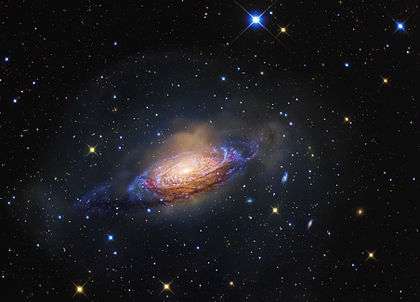Astronomy and Astrophysics program of SUPARCO

The Astronomy and Astrophysics program (or SUPARCO Astrophysics program), is an active scientific mission of the Space Research Commission (SUPARCO), dedicated for the development of space science.[1] The program's mainstream objective and aim is to conduct research studies for the advancement and better understanding of the theoretical physics, astronomy, astrophysics, and mathematics involving the three-dimensional universal space and time.[1]
Launched and established in January 2012, the program takes scientific and research studies pertaining to quantum mechanics, deep space objects, dark matter and energy, supernova, nebulae and galaxies mentioned in the Big bang theory. Under its new designated official space policy which was approved by the Prime minister of Pakistan Yousaf Raza Gillani, the program inter-alia cohesively included the augmentation and strengthening of the understanding of physics and mathematics in the country, as part of the scientific mission of Suparco.[1]
Overview
The program is promoted in the public circles through an academic bulletin which was launched on 2 January 2012 by Suparco.[2] The program is intended to provide initial and better understanding of the space and astronomy and to create awareness among professionals, amateur astronomers, educators, students and public at large about the progress made in this field through technological innovations.[2] The program was launched with the Space program 2040 (an official space policy of Government of Pakistan) after being approved by the Prime minister Yousaf Raza Gillani to enhance the separate astronomy and astrophysics programmes of SUPARCO, under one programme. This program is mainly focused on theoretical and observational research while collaborating with major space agencies in the world.[3] The genesis of this program traced back to 2009 after Suparco publicly celebrated the International Year of Astronomy which was widely appreciated by the public.[4] Since then, Suparco managed and helds the World Space Week events and functions all over the country to educate the public circles in the notable areas of interest of astrophysics.[5]
Currently, Suparco is planning to established its own version astronomical observatory, apart from the control of the universities and institutions, to conduct furthermore theoretical research in astrophysics and mathematics.[3] On monthly basis, Suparco through its bulletin covers the research events and book reviews as well as work being carried out at SUPARCO under this program.[2][6]
Scientific research and publications
In January 2012, the program was launched its publishing its first publication in its bulletin.[1] The first publication under this program included the research on upper atmosphere, software development relating the space technology, Lunar theory, Lunar eclipse Quadrantids and the asteroids.[1] Since its establishment, a total of nine important publications has been released under the auspicious of this program with the last volume was issued in September 2012.[7]
Notes
- 1 2 3 4 5 SUPARCO; et al. (January 2012). "Our Sky (first introduction)" (PDF). SUPARCO Astronomy & Astrophysics Bulletin. 1 (1): 1–6. Retrieved 29 September 2012.
- 1 2 3 Front News Desk (3 January 2012). "SUPARCO to launch astronomy bulletin". Daily Times, Pakistan. Retrieved 29 September 2012.
- 1 2 Iqbal, Muhammad (2 January 2012). "SUPARCO will launch astrophysics bulletin". Brecorder online. Retrieved 29 September 2012.
- ↑ Suparco. "International Year of Astronomy". SUPARCO Space awareness division. Retrieved 29 September 2012.
- ↑ "World Space Week 2012 i". Suparco Space Science division. Retrieved 29 September 2012.
- ↑ "SUPARCO Astrophysics Program". Government of Pakistan. Space and Upper Atmosphere Research Commission. Retrieved 29 September 2012.
- ↑ Zareen, Rizla. "The Astronomy and Astrophysics Program". The Astrophysics Program.